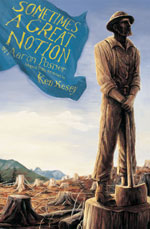Our friend Rose City Reader has a running feature on her lively lit blog she calls Opening Sentence of the Day, and it’s just that — a first sentence that, for some reason, catches her eye and ear and compels her to pass it along.
 It’s a great idea, and it’s hers, and no way am I going to steal it, because that would be so wrong. But just this once I’m going to borrow it, because after putting new shelves in the office I’ve been restocking some books that have been sitting in boxes in the basement, and that includes pretty much my entire collection of mysteries, which I’ve now been taking out selectively and re-reading with pleasure.
It’s a great idea, and it’s hers, and no way am I going to steal it, because that would be so wrong. But just this once I’m going to borrow it, because after putting new shelves in the office I’ve been restocking some books that have been sitting in boxes in the basement, and that includes pretty much my entire collection of mysteries, which I’ve now been taking out selectively and re-reading with pleasure.
One of my rediscoveries is Gore Vidal’s three murder mysteries from the early 1950s featuring suave public-relations man Peter Sargeant (Vidal wrote them under the pen name Edgar Box) — Death in the Fifth Position, maybe the best backstage ballet murder mystery ever written; Death Before Bedtime, a maliciously funny evisceration of power, sex and corruption in the nation’s capital; and Death Likes It Hot, a mystery about — well, I can’t remember exactly, because I haven’t read it in a long time and I’ve just begun it again. But its first sentence is so delicious that I just have to take a cue from Rose City Reader and pass it along. (I can’t resist adding the second sentence, too, because it underscores the method of Vidal’s elegant wry comedy):
The death of Peaches Sandoe, the midget, at the hands, or rather feet, of a maddened elephant in the sideshow of the circus at Madison Square Garden was at first thought to be an accident, the sort of tragedy you’re bound to run into from time to time if you run a circus with both elephants and midgets in it. A few days later, though, there was talk of foul play.
Ah, the wonderful tastelessness of it all! Isn’t that what we long for in a comedy-of-manners murder mystery, even moreso than an alibi-proof plot?
And that got me thinking of my old friend and fellow ink-stained wretch Vince Kohler, who died too early, at age 53, several years ago, but not before creating his wonderfully seedy reprobate of an amateur sleuth, Eldon Larkin, an “overweight, oversexed reporter” on a daily newspaper in a mythical town on the southern Oregon coast. (Kohler, who when I knew him was a reporter for The Oregonian, where Berkeley escapee Eldon hoped a good scoop might someday land him a job, was once a reporter at the Coos Bay World.)
Continue reading Sunday scatter: It was a dark and stormy night in the Rainy North Woods …
 Dismantling Paradise is hard work. Accomplishing it by proxy, such as in writing a novel, also takes its toll. Perhaps that’s why
Dismantling Paradise is hard work. Accomplishing it by proxy, such as in writing a novel, also takes its toll. Perhaps that’s why  The findings in the
The findings in the